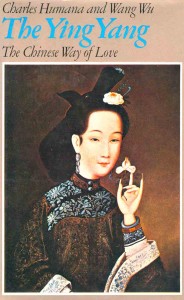 Upon reading Charles Humana and Wang Wu’s The Ying Yang: The Chinese Way of Love (1971, SBN 85523 019 3), it’s pretty apparent that the Chinese have been studying the art of love-making for a long, long time. This fascinating book isn’t merely about sex positions, either. Here at WoWasis, we were transfixed and mortified by the chapter entitled The duties and the Desires of the Eunuch, with subheadings such as these: The Effects and Techniques of Castration, His search for the means of restoring his lost virility, His use of Sex instruments, His role as executioner and torturer. Sobering material.
Upon reading Charles Humana and Wang Wu’s The Ying Yang: The Chinese Way of Love (1971, SBN 85523 019 3), it’s pretty apparent that the Chinese have been studying the art of love-making for a long, long time. This fascinating book isn’t merely about sex positions, either. Here at WoWasis, we were transfixed and mortified by the chapter entitled The duties and the Desires of the Eunuch, with subheadings such as these: The Effects and Techniques of Castration, His search for the means of restoring his lost virility, His use of Sex instruments, His role as executioner and torturer. Sobering material.
Humana and Wang provide a historical basis for Chinese lovemaking through a discussion of Confucianism and Taoism, and make liberal use of old texts and stories to underscore the differing sexual mores of varying dynasties and times. And they seemingly leave no stone unturned, from foot binding practices to sex instruments to scatological practices, all in 248 pages, each of which has compelling information. There’s a nice bibliography, too.
The brothel was a well-established venue in old China, and the following pieces of advice — to customers as well as providers — are timeless:
Advice to Men Visiting Brothels, by Li Shang-Yin
Do not boast of your prowess as a lover.
Do not make excuses for your failures.
Do not perform your toilet in her presence.
Do not spit on the matting.
Do not bore holes in the partition to observe others making love.
Do not make false promises to her.
Do not flatter her with poems unless they are sincere.
Do not believe her flattery or loving words.
Do not make it apparent that you covet her ‘foster-sisters’.
Do not steal her possessions on the pretext of borrowing.
Advice to women from a ‘foster mother’ (mama-san)
If a man returns to your side four or five times in the
same week, and insists on your company rather than that
of one of the other girls, the time has come to raise your
price. After all, if he wishes to monopolise you, he must
pay extra. It is more profitable and more gracious, how-
ever, to obtain this extra in the form of presents. The girl
should indicate discreetly that she is wearing nothing to
indicate his love for her, while the other girls in the estab-
lishment are constantly flaunting the Jewellery they have
received. This is the kindest way of saying that she expects
to be taken on a visit to a jeweller’s, arrangements already
having been made with the jeweller about the pieces that
should be recommended to them. When the visit takes
place the girl should show no eagerness for expensive
pieces since they will be suggested by the craftsman. If the
finest pieces do not meet with the approval of the lover,
this is because they are too expensive. After criticising the
fine pieces, however, he will still buy what he cannot really
afford. When he has been persuaded to do this, remove
the Jewellery you are wearing, and which he knows to be
a present from a previous lover, and contemptuously
throw it into the craftsman’s waste-basket. This discarded
piece will later be returned by the jeweller.
The texts quoted in the book spare no one, and Chinese writers could be extremely opinionated about and condescending to Westerners, as quoted from The Diary of Tseng Kuo-Ting (Advanced Publishing Society, Peking, 1932):
… there are two features of western women that
hardly gain favour with the Chinese male. The rawness of
her odours are exactly as one would expect from ‘raw’
barbarians, and no amount of soap or scent can change
this. Secondly, the pubic hair of many western women –
how coarse it seems after the Chinese female. It reminds
one of riding camels and donkeys bareback, rough and
wiry, and sometimes extending in a fuzz towards navel or
knees.
All in all, we found this book to be a fascinating look at how the Chinese view (or viewed) themselves in fundamental matters related to sexuality. Although paid sex is officially illegal in today’s China, Chinese practitioners of the craft today work all over the world, and this book goes a long way to explaining many of the historical philosophies relating to sexual practices that perhaps color the thoughts of the management and workers in today’s Chinese-run erotic establishments.
This book was more or less updated by Humana & Wu in 1984 (ISBN 062-7031-26-7)and called ‘Chinese Sex Secrets: a look Behind the Screen.’ This later iteration is larger format, 8″x11.25″ but fewer pages, 159 compared to the earlier book’s 253. The earlier book has one picture, the later book has tons. They’re both worth having, but we prefer the more precise scholarship of the early edition.